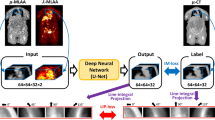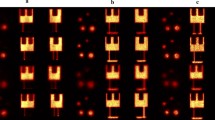Abstract
Purpose
We compared conventional filtered back-projection (FBP), two-dimensional-ordered subsets expectation maximization (OSEM) and maximum a posteriori (MAP) NEMA NU 4-optimized reconstructions for therapy assessment.
Procedures
Varying reconstruction settings were used to determine the parameters for optimal image quality with two NEMA NU 4 phantom acquisitions. Subsequently, data from two experiments in which nude rats bearing subcutaneous tumors had received a dual PI3K/mTOR inhibitor were reconstructed with the NEMA NU 4-optimized parameters. Mann–Whitney tests were used to compare mean standardized uptake value (SUVmean) variations among groups.
Results
All NEMA NU 4-optimized reconstructions showed the same 2-deoxy-2-[18F]fluoro-d-glucose ([18F]FDG) kinetic patterns and detected a significant difference in SUVmean relative to day 0 between controls and treated groups for all time points with comparable p values.
Conclusion
In the framework of therapy assessment in rats bearing subcutaneous tumors, all algorithms available on the Inveon system performed equally.







Similar content being viewed by others
References
Maynard J, Ricketts SA, Gendrin C et al (2013) 2-Deoxy-2-[18F]fluoro-d-glucose positron emission tomography demonstrates target inhibition with the potential to predict anti-tumour activity following treatment with the AKT inhibitor AZD5363. Mol Imaging Biol 15:476–485
Perumal M, Stronach EA, Gabra H, Aboagye EO (2012) Evaluation of 2-deoxy-2-[18 F]fluoro-d-glucose- and 3′-deoxy-3′-[18 F]fluorothymidine-positron emission tomography as biomarkers of therapy response in platinum-resistant ovarian cancer. Mol Imaging Biol 14:753–761
Fueger BJ, Czernin J, Hildebrandt I et al (2006) Impact of animal handling on the results of 18 F-FDG PET studies in mice. J Nucl Med 47:999–1006
Chatziioannou A, Qi J, Moore A et al (2000) Comparison of 3-D maximum a posteriori and filtered backprojection algorithms for high-resolution animal imaging with microPET. IEEE Trans Med Imaging 19:507–512
van Dalen JA, Visser EP, Vogel WV et al (2007) Impact of Ge-68/Ga-68-based versus CT-based attenuation correction on PET. Med Phys 34:889–897
Chang E, Liu S, Gowrishankar G et al (2011) Reproducibility study of [(18)F]FPP(RGD)2 uptake in murine models of human tumor xenografts. Eur J Nucl Med Mol Imaging 38:722–730
Dandekar M, Tseng JR, Gambhir SS (2007) Reproducibility of 18F-FDG microPET studies in mouse tumor xenografts. J Nucl Med 48:602–607
Tseng JR, Dandekar M, Subbarayan M et al (2005) Reproducibility of 3′-deoxy-3′-(18)F-fluorothymidine microPET studies in tumor xenografts in mice. J Nucl Med 46:1851–1857
Whisenant JG, Peterson TE, Fluckiger JU et al (2013) Reproducibility of static and dynamic (18)F-FDG, (18)F-FLT, and (18)F-FMISO microPET studies in a murine model of HER2+ breast cancer. Mol Imaging Biol 15:87–96
Aide N, Visser EP, Lheureux S et al (2012) The motivations and methodology for high-throughput PET imaging of small animals in cancer research. Eur J Nucl Med Mol Imaging 39:1497–1509
Pichler BJ, Wehrl HF, Judenhofer MS (2008) Latest advances in molecular imaging instrumentation. J Nucl Med 49(Suppl 2):5S–23S
Qi J, Leahy RM, Cherry SR et al (1998) High-resolution 3D Bayesian image reconstruction using the microPET small-animal scanner. Phys Med Biol 43:1001–1013
Visser EP, Disselhorst JA, Brom M et al (2009) Spatial resolution and sensitivity of the Inveon small-animal PET scanner. J Nucl Med 50:139–147
Engelman JA, Chen L, Tan X et al (2008) Effective use of PI3K and MEK inhibitors to treat mutant Kras G12D and PIK3CA H1047R murine lung cancers. Nat Med 14:1351–1356
Kant R, Constantinescu CC, Parekh P et al (2011) Evaluation of F-nifene binding to alpha4beta2 nicotinic receptors in the rat brain using microPET imaging. EJNMMI Res 1:6
Pandey SK, Kaur J, Easwaramoorthy B et al (2014) Multimodality imaging probe for positron emission tomography and fluorescence imaging studies. Mol Imaging 13:1–7
Parthoens J, Verhaeghe J, Stroobants S, Staelens S (2014) Deep brain stimulation of the prelimbic medial prefrontal cortex: quantification of the effect on glucose metabolism in the rat brain using [18F]FDG microPET. Mol Imaging Biol
Goertzen AL, Bao Q, Bergeron M et al (2012) NEMA NU 4-2008 comparison of preclinical PET imaging systems. J Nucl Med 53:1300–1309
Disselhorst JA, Brom M, Laverman P et al (2010) Image-quality assessment for several positron emitters using the NEMA NU 4-2008 standards in the Siemens Inveon small-animal PET scanner. J Nucl Med 51:610–617
Liu X, Laforest R (2009) Quantitative small animal PET imaging with nonconventional nuclides. Nucl Med Biol 36:551–559
Aide N, Desmonts C, Briand M et al (2010) High-throughput small animal PET imaging in cancer research: evaluation of the capability of the Inveon scanner to image four mice simultaneously. Nucl Med Commun 31:851–858
Siepel F, van Lier M, Chen M et al (2010) Scanning multiple mice in a small-animal PET scanner: influence on image quality. Nucl Instrum Methods Phys Res A 621:605–610
Lasnon C, Quak E, Briand M et al (2013) Contrast-enhanced small-animal PET/CT in cancer research: strong improvement of diagnostic accuracy without significant alteration of quantitative accuracy and NEMA NU 4-2008 image quality parameters. EJNMMI Res 3:5
Harteveld AA, Meeuwis AP, Disselhorst JA et al (2011) Using the NEMA NU 4 PET image quality phantom in multipinhole small-animal SPECT. J Nucl Med 52:1646–1653
Difilippo FP, Patel S, Asosingh K, Erzurum SC (2012) Small-animal imaging using clinical positron emission tomography/computed tomography and super-resolution. Mol Imaging 11:210–219
Rosslyn V (2008) NEMA: NEMA standards publication NU 4-2008: Performance measurements for small animal positron emission tomographs
Chow PL, Rannou FR, Chatziioannou AF (2005) Attenuation correction for small animal PET tomographs. Phys Med Biol 50:1837–1850
Prasad R, Zaidi H (2014) Scatter characterization and correction for simultaneous multiple small-animal PET imaging. Mol Imaging Biol 16:199–209
Loening AM, Gambhir SS (2003) AMIDE: a free software tool for multimodality medical image analysis. Mol Imaging 2:131–137
Lheureux S, Lecerf C, Briand M et al (2013) (18)F-FDG is a surrogate marker of therapy response and tumor recovery after drug withdrawal during treatment with a dual PI3K/mTOR inhibitor in a preclinical model of cisplatin-resistant ovarian cancer. Transl Oncol 6:586–595
Visser EP, Disselhorst JA, van Lier M et al (2011) Characterization and optimization of image quality as a function of reconstruction algorithms and parameters settings in a Siemens Inveon small-animal PET scanner using the NEMA NU 4-2008 standards. Nucl Instrum Methods Phys Res A 629:357–367
Kinahan PE, Hasegawa BH, Beyer T (2003) X-ray-based attenuation correction for positron emission tomography/computed tomography scanners. Semin Nucl Med 33:166–179
Huisman MC, Reder S, Weber AW et al (2007) Performance evaluation of the Philips MOSAIC small animal PET scanner. Eur J Nucl Med Mol Imaging 34:532–540
Wang Y, Seidel J, Tsui BM et al (2006) Performance evaluation of the GE healthcare eXplore VISTA dual-ring small-animal PET scanner. J Nucl Med 47:1891–1900
de Jong GM, Hendriks T, Bleichrodt RP et al (2012) 18F-2-deoxy-2-fluoro-d-glucose positron emission tomography, computed tomography, and magnetic resonance imaging for the detection of experimental colorectal liver metastases. Mol Imaging 11:148–154
Quarta C, Cantelli E, Nanni C et al (2013) Molecular imaging of neuroblastoma progression in TH-MYCN transgenic mice. Mol Imaging Biol 15:194–202
Deleye S, Heylen M, Deiteren A et al (2014) Continuous flushing of the bladder in rodents reduces artifacts and improves quantification in molecular imaging. Mol Imaging 13:1–12
Acknowledgment
Dr Alison Johnson and Pauline Aide are thanked for manuscript proofreading.
Funding
This work was supported by a grant from the French Ligue contre le cancer, Comité du Calvados.
Conflict of Interest
The authors declare that they have no conflict of interest.
Ethical Approval
“All procedures performed in studies involving human participants were in accordance with the ethical standards of the institutional and/or national research committee and with the 1964 Helsinki declaration and its later amendments or comparable ethical standards.”
Author information
Authors and Affiliations
Corresponding author
Electronic Supplementary Material
Below is the link to the electronic supplementary material.
ESM 1
(PDF 3705 kb)
Rights and permissions
About this article
Cite this article
Lasnon, C., Dugue, A.E., Briand, M. et al. NEMA NU 4-Optimized Reconstructions for Therapy Assessment in Cancer Research with the Inveon Small Animal PET/CT System. Mol Imaging Biol 17, 403–412 (2015). https://doi.org/10.1007/s11307-014-0805-5
Published:
Issue Date:
DOI: https://doi.org/10.1007/s11307-014-0805-5




